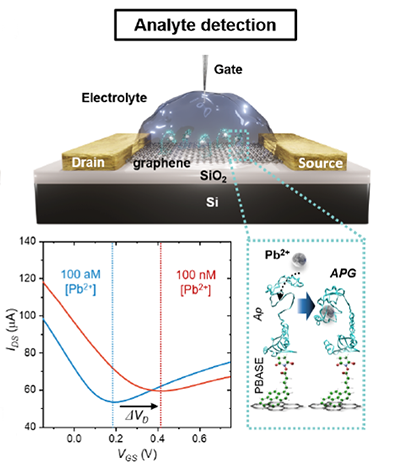
Illustration of the device. Inset shows surface modification of the single layer of graphene with a linker, which anchors an ion receptor that exclusively binds lead ions. Image Credit: Bandaru Lab/UC San Diego
Nano Letters published the findings.
A single layer of graphene positioned on a silicon wafer makes up the device used in this investigation. Graphene presents a perfect platform for sensing applications because of its exceptional surface-to-volume ratio and conductivity.
The graphene layer’s sensing abilities were improved by the researchers by adding a linker molecule to its surface. A proton receptor and, eventually, the lead ions are anchored by this linker.
Making the sensor extremely selective for lead ion detection was one of the main contributions of this study. An aptamer, a brief single strand of DNA or RNA, was employed by the researchers to serve as the ion receptor. The intrinsic selectivity of these receptor molecules for particular ions is well recognized.
By modifying the DNA or RNA sequence of the receptor, the researchers were able to significantly increase its binding affinity for lead ions. By doing this, it was made sure that the sensor would only activate when it bonded to lead ions.
It was feasible to reach the femtomolar limit of detection by closely examining the chemical processes taking place on the graphene sensor’s surface. The progressive adhesion of the linker to the graphene surface, the receptor’s binding to the linker, and the lead ions’ attachment to the receptor were all seen by the researchers using a mix of theoretical and experimental methods.
After examining thermodynamic system characteristics such as binding energies, capacitance variations, and molecular conformations, the researchers discovered that these factors were crucial for maximizing the sensor’s efficiency.
Through the optimization of all these thermodynamic factors and system design, from materials and electronics to the ion receptor, the researchers have developed a sensor capable of lead ion detection with unprecedented levels of sensitivity and specificity.
“The work truly exemplified collaboration and synergy among all contributors. The foundational device considerations and protocols were established by Yongliang Dong, who is presently working at LAM Corporation. Deependra Ban, a brilliant biochemist, designed the state-of-the-art aptamers used for lead detection. Shreyam Natani’s keen insights and atomic force microscopy work yielded new perspectives. Alex Lee, the lead author, carried out the experimental work with unwavering persistence,” Bandaru added.
Beyond its enhanced sensitivity, the new sensor offers additional benefits over current approaches. Conventional methods for high-sensitivity and high-accuracy lead detection frequently depend on costly instrumentation, making them unsuitable for widespread application. On the other hand, home kits, although more readily available, are frequently unstable and have a relatively low detection limit, usually in the micromolar range.
Bandaru further stated, “The technology that we developed aims to overcome the issues of cost as well as reliability. Our goal is for it to be eventually deployed in homes, given its relative ease of manufacture.”
Although the technique is still in the proof-of-concept phase, Bandaru intends to eventually use it in practical applications. The production will need to be scaled up for commercial usage, which will require working with industry partners.
Alex W. Lee, Yongliang Dong, and Shreyam Natani, UC San Diego; and Deependra Kumar Ban, Keck Graduate Institute are the co-authors of the study titled “Toward the Ultimate Limit of Analyte Detection, in Graphene-Based Field-Effect Transistors.”
The Army Research Office (W911NF-21-1-0041-(74813-MS)) provided funding for this study.
Journal Reference
Lee, A. W., et. al. (2024). Toward the Ultimate Limit of Analyte Detection, in Graphene-Based Field-Effect Transistors. Nano Letters. doi:10.1021/acs.nanolett.3c04066